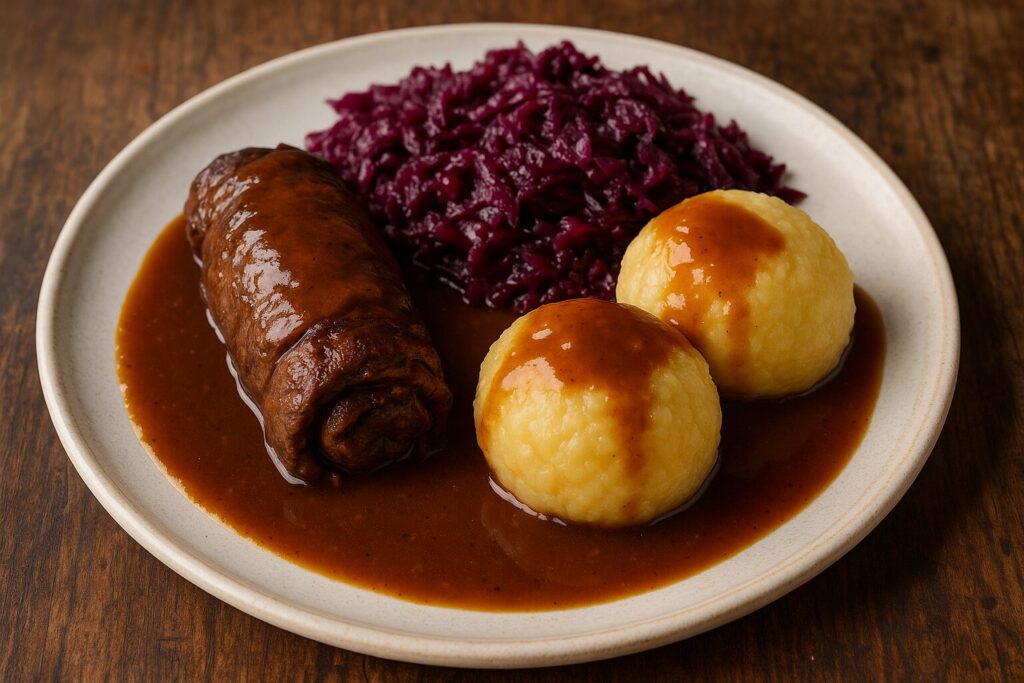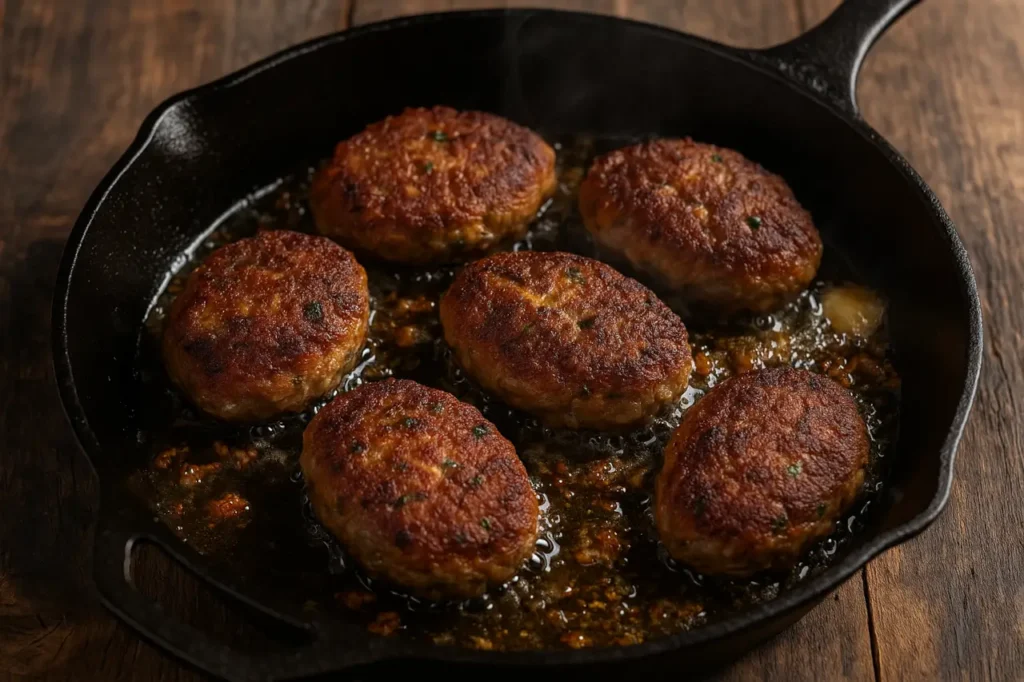Picture this: a hearty, comforting dish, swirling with savory flavors, perfect for a cozy autumn evening. We’re talking about German Beef Rouladen! So flavorful and tender, this is one German recipe you have to try!
Rouladen speaks to a slower, more traditional era of cooking. As I was growing up, Rouladen was always a very special dinner—something my father made on rare, celebratory evenings. The savory scent of bacon, pickles, and onions fragrant with mustard would fill the house, and all of us kids could hardly wait for dinner time.
Historically, Rouladen likely has roots in French cuisine, derived from the word rouler, meaning “to roll.” German cooks adapted the idea, layering thin slices of beef with mustard, onions, bacon, and pickles – simple yet flavorful pantry staples – then rolling and braising them to tender perfection. Originally served in noble households in the 1700s when beef was a luxury, Rouladen eventually became a Sunday dinner tradition in many German homes as the meat became more widely available.
Just a heads-up: my father made this by instinct – no recipe in hand – so this version is my best faithful recreation of how he did it. Fair warning: these are rich and satisfying, so feel free to double the recipe – personally, I could easily manage two (or even three!).

German Beef Rouladen
Ingredients
Equipment
Method
- In a skillet over medium heat, cook the chopped bacon until crispy. Remove and drain on paper towels.
- In the same skillet, sauté the diced onions in the bacon fat until translucent. Let cool slightly.
- Lay the round steaks flat on a clean surface. Season both sides with salt and pepper.
- Spread a thin layer of mustard over each steak.
- Place a small spoonful of diced pickle, diced onions, and some chopped bacon on one end of each steak.
- Roll the steaks tightly from the filled end, keeping the ends tucked in and secure with toothpicks or kitchen twine. (We used toothpicks)
- In a large skillet or Dutch oven, heat oil over medium-high heat. Brown the Rouladen on all sides, about 2-3 minutes per side. Remove and set aside.
- In the same skillet, add a bit more oil if necessary, and scrape up the browned bits from the bottom.
- Add the beef broth and red wine, if using. Bring to a simmer and let it reduce slightly.
- Stir in the flour to thicken the sauce, whisking until smooth.
- Return the browned rouladen to the skillet, covering them with the sauce.
- Reduce heat to low, cover, and let simmer for about 1.5 to 2 hours until the meat is tender.
- Remove toothpicks or twine from rouladen before slicing.
- Serve hot, drizzled with the gravy sauce and garnished with fresh parsley.
Nutrition
Enjoy your delicious homemade German Rouladen!



FAQ
What’s the best cut of beef to use for German Beef Rouladen, and why?
That’s a great question! Traditionally, thinly sliced top round or bottom round is used for Rouladen. These cuts are relatively lean and become wonderfully tender during the long braising process. They need to be sliced thinly – about 1/8 inch thick – so they roll easily and cook evenly. If you can’t find pre-sliced round steak, ask your butcher to slice it for you. They’ll know exactly what you need! You could also use flank steak, pounded thin, as an alternative, though it might have a slightly different texture.
Can I substitute the mustard or other filling ingredients in the Rouladen?
Absolutely! While the classic combination of German mustard, bacon, onions, and pickles is delicious, feel free to experiment. For the mustard, try a Dijon or even a whole-grain mustard for a different flavor profile. You could also add finely chopped mushrooms, bell peppers, or even a bit of grated horseradish to the filling. Just be mindful of the overall moisture content – you don’t want the filling to be too wet, or it might leak out during cooking.
What’s the best way to make sure the Rouladen stay tightly rolled during braising?
Keeping those Rouladen snug is key! After rolling, secure them tightly with kitchen twine or butcher’s string. You can also use toothpicks, but be sure to remove them before serving. Another tip is to sear the Rouladen on all sides before braising. This helps to create a nice crust that will hold them together and add depth of flavor to the sauce. Don’t be afraid to be generous with the twine or toothpicks!
What liquid is best for braising the Beef Rouladen, and can I use a slow cooker?
Traditionally, German Rouladen are braised in a mixture of beef broth and red wine. This creates a rich, flavorful sauce. You can also use a good quality dark beer for a more robust flavor. As for the slow cooker, definitely! It’s a fantastic way to get that melt-in-your-mouth tenderness. Just sear the Rouladen, then move them to your slow cooker with the braising liquid. Cook on low for 6-8 hours, or until the beef is very tender. You may need to thicken the sauce afterward by simmering it in a saucepan on the stovetop.
What are some traditional side dishes to serve with Rouladen?
German Rouladen is a hearty dish, so they pair well with comforting sides. Traditional choices include potato dumplings (Kartoffelklöße), spaetzle, mashed potatoes, or boiled potatoes with parsley. Red cabbage (Rotkohl) is another popular accompaniment, because its sweetness balances the savory flavors of the German Rouladen. If you’d like to make a homemade version you can view our German red cabbage recipe here. A side of green beans or a simple salad can also add a touch of freshness to the meal. Enjoy!



